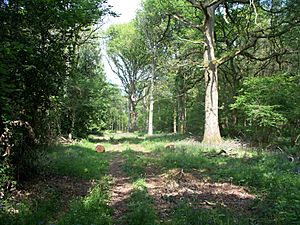Bould Wood facts for kids
| Site of Special Scientific Interest | |
 |
|
| Area of Search | Oxfordshire |
|---|---|
| Interest | Biological |
| Area | 58.2 hectares (144 acres) |
| Notification | 1986 |
| Location map | Magic Map |
Bould Wood is a really special forest in Oxfordshire, England. It covers about 58.2 hectares (144 acres) (that's like 144 football fields!). This amazing place is known as a Site of Special Scientific Interest, or SSSI for short. This means it's protected because it has rare plants, animals, or unique natural features.
Part of Bould Wood, about 23 hectares (57 acres), is called Foxholes nature reserve. This area is looked after by the Berkshire, Buckinghamshire and Oxfordshire Wildlife Trust. They work hard to keep it a safe home for all the wildlife that lives there.
Contents
Discover Bould Wood: A Special Forest
Bould Wood is a fantastic example of an ancient semi-natural woodland. This means it's been a forest for hundreds of years, and the trees and plants that grow there have developed naturally over a very long time. It's not a forest that was planted recently.
What Makes Bould Wood Unique?
This special woodland is home to more than just trees. It also has two small streams that flow through it, a peaceful pond, and a wet meadow. These different habitats make Bould Wood a perfect place for many different kinds of living things to thrive.
Ancient Woodland Wonders
Ancient woodlands like Bould Wood are super important. They are like living museums, showing us what forests were like long ago. They often have very old trees, like oak and ash, and a rich variety of plants on the forest floor. These plants have adapted to living in the shade of the tall trees.
Amazing Plants and Fungi
Bould Wood is famous for its diverse collection of "lower plants." These are plants that don't have flowers, like mosses, liverworts, and lichens. The forest floor is covered in a rich tapestry of these tiny, fascinating organisms.
Tiny Plants, Big Impact
You might not notice them at first, but these small plants play a huge role in the forest's health. They help keep the soil healthy and provide food and shelter for many small creatures.
Fungi and Lichens: Forest Friends
The wood is also home to many interesting fungi. One type found here is the tricholoma toadstool. Another unique fungus is Cudoniella clavus.
Lichens are also very common in Bould Wood. Lichens are actually two organisms living together: a fungus and an alga. They grow on tree bark and rocks. Some lichens you might find here include Cladonia polydactyla, Catillaria prasina, and Graphis scripta. Each of these adds to the rich biodiversity of the forest.
Protecting Bould Wood
Because Bould Wood is a Site of Special Scientific Interest, it gets extra protection. This helps make sure that its unique habitats and the creatures that live there are safe for future generations to enjoy. The Berkshire, Buckinghamshire and Oxfordshire Wildlife Trust does a great job managing parts of the wood, ensuring it remains a healthy and vibrant ecosystem.

